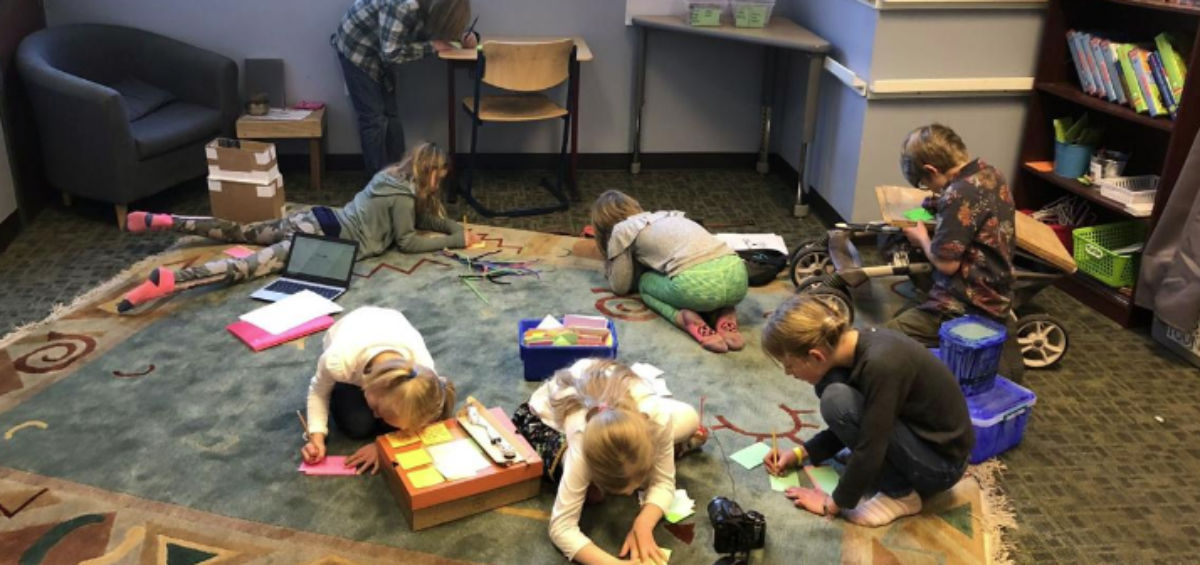Local student patents invention
Telluride Mountain School’s Genius Hour fosters creative ideas
The definition of the word “genius” is “exceptional intellectual or creative power or other natural ability,” which is exactly what the Telluride Mountain School (TMS) aims to foster during its Genius Hour, a creative science block built into the school schedule for students in grades 3-6.
Lower school science teacher Ben Gardner, who brought Genius Hour to TMS when he started teaching there in 2016, sees it as an opportunity for students to work on self-directed projects that foster innovation and lead students to discover personal interests and passions.
“Kids genuinely feel that they are in the driver’s seat and the teacher is just there to help with ideas or getting materials,” Gardner said. “It’s a little more free-form in the sense that students can do whatever they need or want to do.”
During the inaugural year of Genius Hour, current seventh-grader Reeve Johnson invented a magnetic shelf. Johnson, who was in fourth grade that year, constructed two prototypes of the shelf, and added a cup holder, a light and a level indicator.
“It all started with the magnets,” Gardner explained. “Reeve originally wanted to make levitating shoes.”
“Something that pushed apart from each other,” Johnson added.
“He ended up getting these really high-powered magnets that were borderline dangerous,” Gardner said.
Johnson agreed, “They were dangerous.”
“So we had to pivot off the levitating shoes and high-powered magnets into this shelf idea,” Gardner said. “Maybe for RV’s or any sort of metal wall.”
With the help of a patent lawyer, Johnson sought a provisional patent for his magnetic shelf. Once that was approved — and only 20 percent of all provisional patents are approved — he went on to file required documents, mechanical drawings and photos, and recently received an official U.S. patent.
“I was curious about what the patenting process was like because I might want to pursue it in the future for another idea,” Johnson said.
Johnson added that if you have a good idea, it’s worth it to pursue a patent because when his came back, it informed him more about his shelf and how magnets work than he ever knew.
In the years since inventing his magnetic shelf, Johnson has used Genius Hour to study for an out-of-school coding class offered though Johns Hopkins University’s Center for Talented Youth. Not only has the patenting experience sparked an interest in electronics, Johnson is currently mulling over an idea for a motorized pen that recognizes patterns to address handwriting challenges.
“I’m really proud of Reeve,” Gardner said. “His following through and getting the patent gives other kids the ability to see that this could turn into something way bigger than just a class.”
Ultimately, Gardner added, Genius Hour enables students to experience the “ideating” process.
“Genius Hour gives kids an opportunity to practice those skills that they’ll need in life after school,” Gardner said. “Allowing them space and time to be creative and to learn the process of how an invention is created and to pursue something they’re interested in.”
Where Genius Hour remains less structured creative science time, Invention Convention and science fair are new subtopics for students who need help with the idea generation process.
“The Invention Convention is STEM-related and pushes students to come up with an invention that will solve a problem in their lives,” Gardner explained. “This year is more traditional where all students do a different science fair experiment.”
On Monday, TMS announced 12 Genius Hour projects that will be shown at the second annual Community Science Fair at the Wilkinson Public Library (WPL) Jan. 25 from 4-6 p.m.
Wyeth Rose will demonstrate the difference between growing organic grass vs. grass treated with Miracle Gro; Alden Arndt will explain how different types of foods affect heart rates; Greyson Phelan will show how the human nose differentiates between artificial and natural smells; Lola Randall will indicate the temperature at which raspberries grow mold; Belle McTigue will share a study of the closed loop on a type 1 diabetes dexcom system; Lille Pearl Williamson will prove which sunscreen is the most protective; Lyssa Neumann will show how music affects focus; Piper Allen will prove what seed color birds like best; Revi Hawkins will share a bacteria study of homeroom doors at TMS; Holt Carter will demonstrate the strongest paper towel brand; Laken Hawkins will share a study on the best football gloves; and Ruby Cieciuch will demonstrate how to read for right answers.
The Community Science Fair, a collaboration of WPL, the Pinhead Institute, the Ah Haa School and Telluride Intermediate science teacher Colin Hubbard, is open to anyone and has no age restrictions.
“This is truly a community event,” said Tiffany Osborne, service specialist at WPL and originator of the event. “We encourage families, adults, kids, students, anyone can sign up for the Community Science Fair.”
This year, there are three categories for participation: Life Sciences, Rube Goldberg, and new this year, The Design Challenge. For more information on this year’s Community Science Fair, visit telluridelibrary.org.
By- Amy Peters
Telluride Daily Planet Coordinator





Leave a Comment